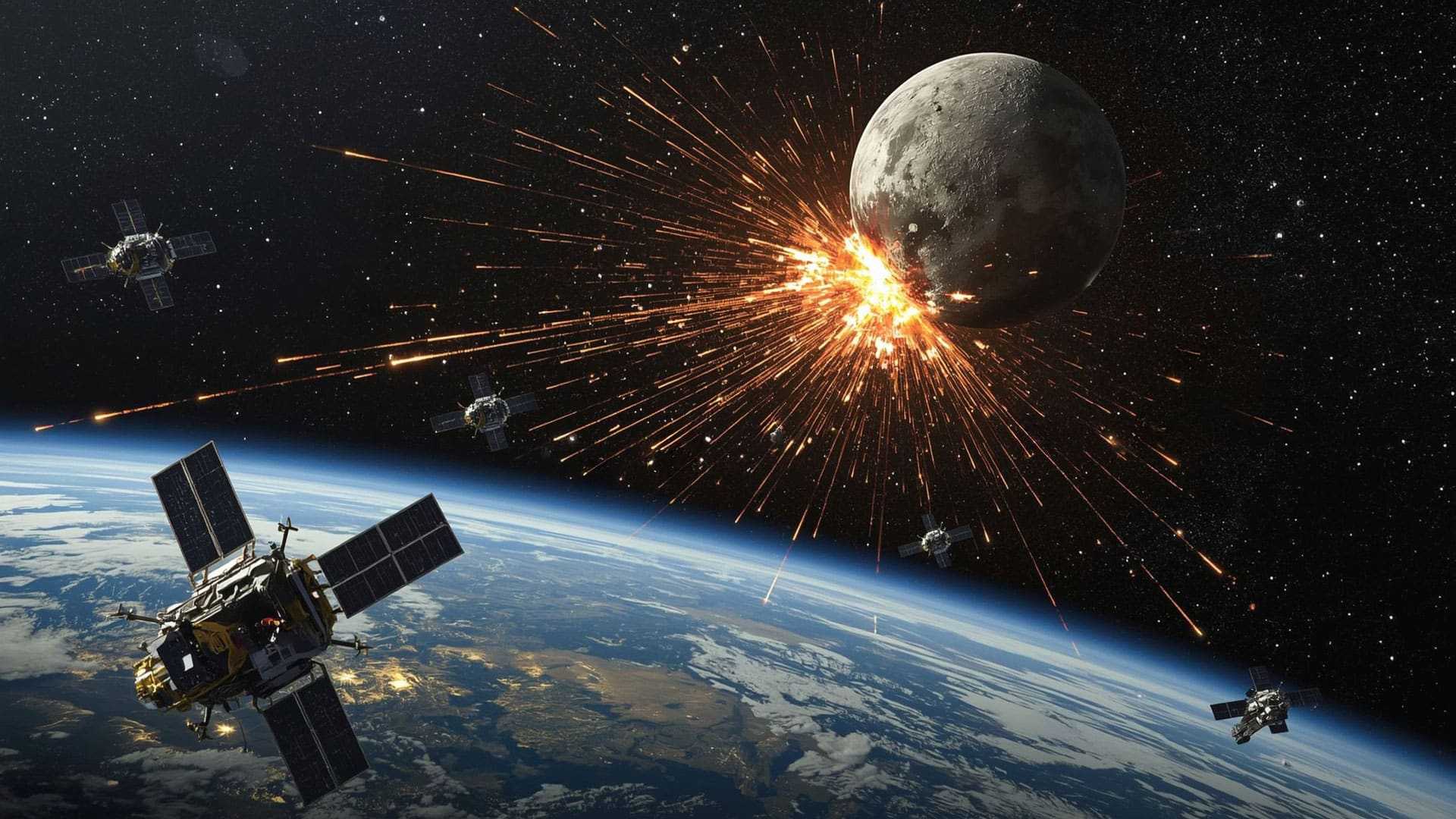Lunar Fallout: How a 2024 YR4 Moon Strike Could Threaten Earth’s Satellites

When asteroid 2024 YR4 rocketed onto NASA’s risk tables last year, headlines focused on its fleeting 3 % chance of striking Earth. Subsequent tracking dismissed that fear—but left a 4 % probability of a direct lunar hit on 22 December 2032. A new, peer-reviewed preprint from University of Western Ontario astronomer Paul Wiegert and co-authors asks an overlooked question: what happens to Earth-orbiting satellites if the Moon gets whacked by a 60-metre rock? The answer, according to their models, is unsettling: the ejecta plume could shower low-Earth orbit (LEO) with decades’ worth of micrometeoroid impacts in a matter of days.
In this article we unpack the 30-page study, walk through the physics of high-velocity lunar ejecta, and explore how the Space Age’s densest orbital shell could endure a meteor storm unlike any in recorded history.
Study Overview
| Attribute | Details | |--|| | Paper | The Potential Danger to Satellites due to Ejecta from a 2032 Lunar Impact by Asteroid 2024 YR4 | | Authors | Paul Wiegert, Peter Brown, Jack Lopes & Martin Connors | | Repository | arXiv 2506.11217 (June 2025) | | Key Finding | Up to 10⁸ kg of lunar rock could escape, boosting micrometeoroid flux in near-Earth space by years–to-decades worth of background in mere days. |
The work combines hydrodynamic impact codes, ballistic trajectories, and satellite-flux models (MEM 3) to estimate debris sizes from 0.1 mm to 10 mm—tiny but deadly at orbital speeds.
Impact Energy & Crater Size
A 60 m stony body striking the lunar surface at ~11 km/s releases 6.5 megatons of TNT (≈ 270 Petajoules). That’s enough to blast a ~1 km-wide crater. Comparable terrestrial energy releases include:
- Chelyabinsk (2013): 400–500 kt
- Castle Bravo (1954 H-bomb): 15 Mt
- Tunguska (1908): 3–15 Mt
On the airless Moon, ejecta aren’t slowed by atmosphere. Anything accelerated above 2.4 km/s—the Moon’s escape velocity—can sail into cislunar space.
How Much Rock Escapes?
Wiegert’s team ran SOVA hydrocode simulations:
- Total ejecta ≥ escape speed: 10⁸ kg (roughly 10 Great Pyramids of Giza)
- Particle size distribution: Dominated by sand-grain–sized fragments (0.1–1 mm) but includes centimeter-scale "clinkers."
Trajectories depend on impact latitude and Earth–Moon geometry. If the strike occurs on the near-side hemisphere, up to 10 % of fast ejecta may intersect Earth's Hill sphere within 72 hours.
Satellite Exposure: A Numbers Game
"The lunar ejecta could deliver ten years' worth of normal micrometeoroid hits to every LEO satellite—compressed into a single week." — Wiegert et al. (2025)
Flux Multipliers
Using NASA's MEM 3 environment model, the authors compare background and post-impact flux at 500 km altitude:
| Particle Radius | Nominal Annual Flux (m⁻² yr⁻¹) | Post-Impact Peak (m⁻²) | Effective "Years of Flux" | |--|||| | 0.1 mm | ~5×10⁻⁴ | >2×10⁻² | 40 | | 1 mm | ~2×10⁻⁶ | >1×10⁻³ | 500 | | 5 mm | ~1×10⁻⁹ | ~4×10⁻⁶ | 4000 |
Most spacecraft can shrug off sub-millimetre hits, but cumulative effects include solar-panel pitting, radiative-cooler erosion, and degraded star-tracker optics. For 5 mm fragments, single collisions can be mission-ending.
Vulnerable Constellations
Mega-constellations (Starlink, OneWeb) occupy 300–600 km shells—prime target zones. Mission planners may need to:
- Harden surfaces or add Whipple shields.
- Raise or lower orbital altitudes temporarily.
- Schedule attitude modes that minimise panel cross-section during the high-flux window.
A Meteor Storm on Earth
While satellites dodge hyper-velocity sandblasting, Earth's upper atmosphere would ignite a spectacular meteor outburst. Debris arriving at ~11 km/s produces bright, long-lasting trails. Model estimates:
- Peak Zenithal Hourly Rate (ZHR): 300–1000 meteors/hr
- Duration: 36–48 hours
- Radiant: Near the lunar anti-solar point, drifting nightly
Skywatchers could witness the most intense storm since the Leonids of 1966.
Uncertainties & Next Steps
| Variable | Current Estimate | 2028 Refinement | |-||--| | Impact probability (Moon) | 4.3 % | ±0.5 % | | Diameter (m) | 53–67 | ±5 | | Spin state | 20-min single axis | Confirm NPA tumbling? | | Shape | Flat disk | Radar shape model |
The next close approach in 2028 will brighten YR4 to magnitude 21, enabling radar at Goldstone and bistatic echoes via Green Bank. Those data will lock in the 2032 flyby geometry.
Policy Implications
-
"Cislunar Defence"
Planetary-defence frameworks largely focus on direct Earth impacts. This paper argues for expanding the mandate to protect Earth-orbiting infrastructure from secondary hazards. -
Satellite Insurance & Design
Insurers may ask operators to model rare meteor-storm scenarios. Future LEO platforms could include sacrificial bumpers or momentum-wheel parking modes. -
International Coordination
Space-weather centers (NOAA SWPC, ESA SSA) might integrate "lunar-ejecta alerts" into their dashboards, much like solar-storm advisories.
Communicating Risk Without Hype
Misreading a 4 % lunar chance as "doomsday" is easy. Key messaging points:
- Earth safe. No mass-extinction threat.
- Moon safe (structurally). Orbit unchanged.
- Satellites cautious. Short-term hazard manageable through mitigation.
- Science bonanza. Potential to validate crater-scaling laws.
Balanced outreach prevents "cry-wolf fatigue" while sustaining interest in planetary defence.
Conclusion
The 2506.11217 study stretches planetary-defence thinking beyond gravitational keyholes and Earth-impact corridors. A medium-sized rock hitting an airless world could still rattle the technological cocoon enveloping our planet. Whether asteroid 2024 YR4 ultimately air-kisses the Moon or passes harmlessly by, the modelling exercise itself is invaluable: it forces agencies, operators, and scientists to imagine edge-case scenarios in cislunar space—before reality writes the script.
Bottom line: keep an eye on December 2032. If fate rolls the cosmic dice, humanity may watch a new crater bloom on the Moon's farside—followed days later by the brightest meteor display of the century and a rigorous test of satellite resilience in low-Earth orbit.
Sources: Wiegert, P. et al. (2025) "The Potential Danger to Satellites due to Ejecta from a 2032 Lunar Impact by Asteroid 2024 YR4," arXiv:2506.11217; interviews via Phys.org; NASA CNEOS data.